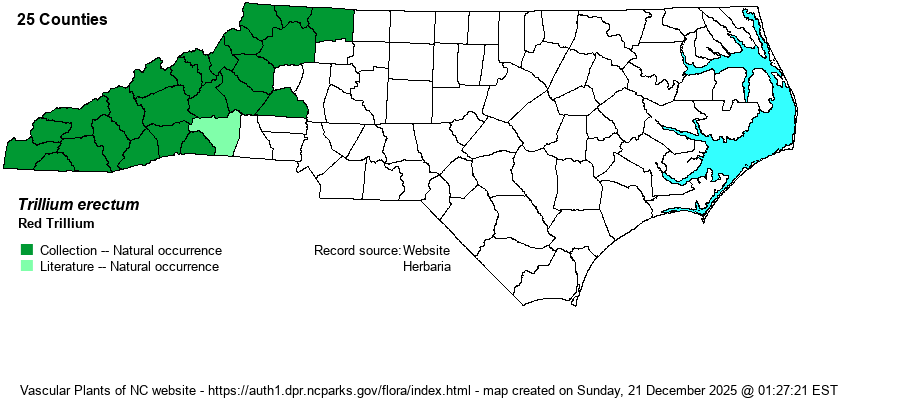| Author | L. | |
| Distribution | Throughout the Mountains and the Piedmont foothills; recorded in every county in the Mountains and east to Surry and Catawba counties.
This is a Northern species found across southern Canada from N.S. to southern Man., south through most of PA to the Appalachians and foothills of northwestern SC and northern GA. It is scarce in the southern Great Lakes region. | |
| Abundance | Common and widespread in the Mountains; infrequent to locally common in the Piedmont foothills. Found in many if not most cove forests in the Mountains. Though it occurs in many fewer counties in NC than T. catesbaei, this may be the most numerous of the state's trillium species in terms of raw number of individuals. This abundance is even so after several montane species have been pulled out of T. erectum as new species in recent decades, such as T. simile and T. sulcatum. | |
| Habitat | This species occurs over a great variety of forested slopes. It is not as strictly tied to circumneutral soils as some trilliums, and it can occur not only in Rich Cove Forests but also in Acidic Cove Forests, as well as in the higher Mountains in Northern Hardwood Forests, and even into the spruce-fir forests. |
| Phenology | Blooms from April to early June, and fruits in July and August. | |
| Identification | Though this is the species an observer is most likely to encounter on a walk in montane and foothill forests, it can be quite variable in flower color, and Weakley (2018) lists two varieties in NC, one essentially with white flowers and the nominate one mostly with deep red to maroon flowers but which can be yellow, greenish-yellow, or intermediate shades. All forms have an erect stem about 1-1.5 feet tall, with three large but non-mottled leaves (i.e., all green), each widely elliptic to rhombic and roughly 5 inches long and 4 inches wide. This species has a fairly tall and usually erect pedicel (flower stalk), carrying the 3-petaled flower about 2-3 inches above the level of the leaves. The petals and green sepals tend to be somewhat in a flat plane, typically facing sideways (horizontally), each being about 1.5 inches long and about 1/2-inch wide and narrowly elliptical to lanceolate. Many plants do have the petals somewhat recurved, but the petals do not form a "cup" like in a few species, and the petals are also narrow enough that they essentially do not overlap their bases. Petals are maroon or dark red (usually redder than on the mottle-leaved species, whose flowers are typically purple-maroon, if not yellow). Both T. simile and T. sulcatum, formerly included within T. erectum, also have the flower held on erect pedicels above the leaves, but each has broadly elliptical or ovate petals that overlap their bases and each has the petals spreading outward to form a cup at the base (i.e., far from being in a single plane). The extremely rare (in NC) T. flexipes is a bit similar to T. erectum, but it has a white to pinkish ovary and usually a somewhat bent and longer pedicel curving the flower somewhat downward. In summary, if you see a trillium with an erect flower stalk, and flowers with narrow petals, no matter if deep red or white (or some other color), it is quite likely to be T. erectum. | |
| Taxonomic Comments | Weakley (2018) has a key stating that the white-flowered form is T. erectum var. album, which grows mostly at the lower elevations. His key has the nominate T. erectum var. erectum, being the red-flowered form, growing mostly at middle and high elevations.
| |
| Other Common Name(s) | Wake-robin, Purple Trillium, Stinking Willie, Stinking Benjamin, and a few other names | |
| State Rank | S5 | |
| Global Rank | G5 | |
| State Status | | |
| US Status | | |
| USACE-agcp | FAC link |
| USACE-emp | FACU link |

